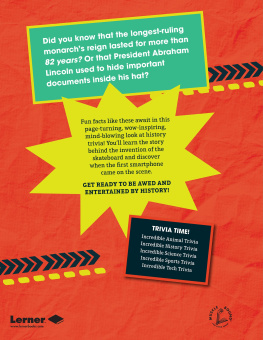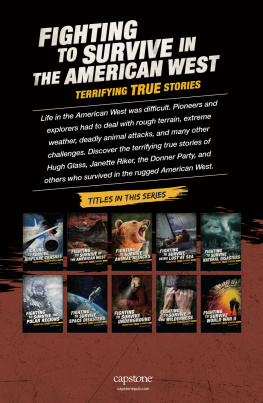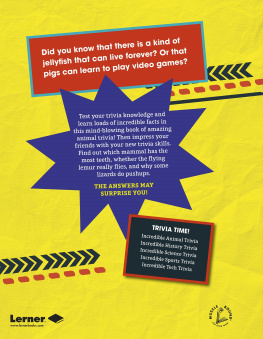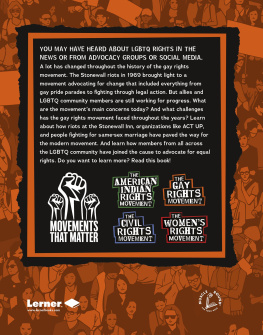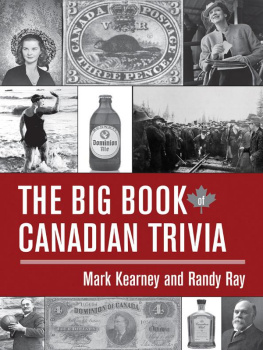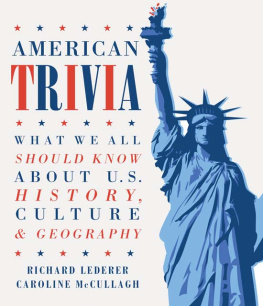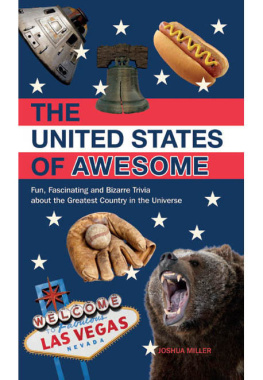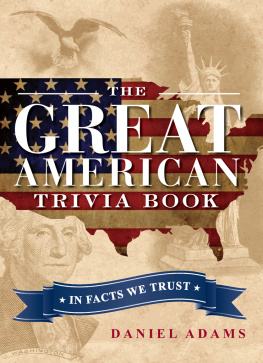Eric Braun
Lerner Publications Minneapolis
Copyright 2018 by Lerner Publishing Group, Inc.
All rights reserved. International copyright secured. No part of this book may be reproduced, stored in a retrieval system, or transmitted in any form or by any meanselectronic, mechanical, photocopying, recording, or otherwisewithout the prior written permission of Lerner Publishing Group, Inc., except for the inclusion of brief quotations in an acknowledged review.
Lerner Publications Company
A division of Lerner Publishing Group, Inc.
First Avenue North
Minneapolis, MN 55401 USA
For reading levels and more information, look up this title at www.lernerbooks.com .
Main body text set in Aptifer Slab LT Pro Regular. Typeface provided by Linotype AG.
Library of Congress Cataloging-in-Publication Data
Names: Braun, Eric, 1971 author.
Title: Incredible history trivia : fun facts and quizzes / Eric Braun.
Description: Minneapolis : Lerner Publications, 2018. | Series: Trivia time! | Includes bibliographical references.
Identifiers: LCCN 2017018682 (print) | LCCN 2017018465 (ebook) | ISBN 9781512483369 (eb pdf) | ISBN 9781512483314 (lb : alk. paper)
Subjects: LCSH: Curiosities and wondersJuvenile literature.
Classification: LCC AG244 (print) | LCC AG244 .B73 2018 (ebook) | DDC 030dc23
LC record available at https://lccn.loc.gov/2017018682
Manufactured in the United States of America
1-43338-33158-8/16/2017
Contents
Q. IBM released the first one in 1994 and named it Simon. What was it?
A. The first phone to feature appsa very early version of the modern smartphone
Can you guess what Nestl paid the inventor of the chocolate chip cookie for the rights to her recipe?
A. $100
B. $100,000
C. $1 million
D. A lifetime supply of Nestl chocolate
If you guessed D, you got it. Inventor Ruth Wakefield got paid in chocolate for her mouthwatering creation. This unusual payment left Wakefield with enough chocolate to bake her famous cookies every day if shed wished.
Did you know inventing the skateboard was a group effort? In the 1950s, surfers in California were looking for a way to enjoy their sport when there were no waves. They slapped wheels from roller skates onto wooden boards and started surfing the sidewalks, and prestothe skateboard was born.
Inventions
Simon
The inventor of the waterbed couldnt get a patent on it because it had already been featured in science fiction novels.
Q. In 1876 a pharmacist named Charles Elmer Hires began selling a beverage he made from sarsaparilla (a plant root that can be used as a flavoring), vanilla beans, and other ingredients. Can you guess what he called it?
A. Root beer
Q. When were anesthetics (numbing medications) first used during surgery?
A. In 1842 when Georgia doctor Crawford Long used sulfuric ether gas to keep a patient comfortable in what otherwise would have been a painful operation. However, a man named William Morton is actually considered the father of anesthesia. He experimented on himself to learn how anesthetics worked. Why didnt Morton become more famous? Perhaps his experiments left him too sleepy to share his results.
Inventions
In World War II (19391945), the Allies (nations such as the United States that fought against Germany and other countries in the war) considered using poisonous snakes as weaponsby air-dropping them.
Wars and Battles
One battle during the third Mithridatic War (ca. 7470 bce ) ended for a strange reason. Can you guess what it was?
A. A meteor landed in the battlefield.
B. One of the generals chased after his loose dog.
C. Everyone started laughing at the same joke.
D. An earthquake rocked the land.
Although any of these events would make for an odd conclusion to a battle, the answer is A. The fighting stopped when a meteor fell from the sky.
During WWII, Adolf Hitler hatched a plan to kill Winston Churchill by hiding a bomb inside chocolate.
Q. What do you think was the shortest war in history?
A. It was probably the Anglo-Zanzibar War (1896). This battle began when a man named Khalid bin Barghash seized control of the throne of Zanzibar. The British demanded that he step down, and when he refused, they bombed his royal palace. Khalid fled the city forty-five minutes later, ending the war.
Q. The Iberian religious wars were the longest-lasting series of battles in history. How many years do you think these battles went on?
A. This string of conflicts between Muslims and Christians continued for yearsfrom to 1492! Both sides saw victories and losses during the drawn-out fight for a piece of land known as the Iberian Peninsula.
Q. The War of the Triple Alliance (ca. 18651870) took an enormous toll on the population of Paraguay ( flag pictured, right ). What percentage of Paraguays men do you think died in the battle?
A. As many as percent of Paraguays males may have been killed in this bloody war between Paraguay and the countries of Brazil, Uruguay, and Argentina.
Q. On March 2, 1955, fifteen-year-old Claudette Colvin bravely did this nine months before Rosa Parks did. What did she do?
A. She refused to move to the back of a segregated bus.
Q. Do you know why its called a strike when employees stop working to force an employer to meet their demands?
A. It goes back to 1768, when English sailors were angry over a wage cut. The sailors reacted by taking down, or striking, the sails on the ships in port. From then on, any stoppage of work to protest working conditions became known as a strike.
In 1977 hundreds of people with disabilities staged sit-ins at US Health, Education, and Welfare offices. They were protesting for disability rights. Many of the sit-ins lasted for a day or even two, but the San Francisco sit-in lasted longer much longer. Protesters in that city kept up their sit-in for nearly a month! For many protesters, the extended sit-in meant going without personal care attendants and medical equipment. The protest still stands out in history as an example of tremendous personal sacrifice.

